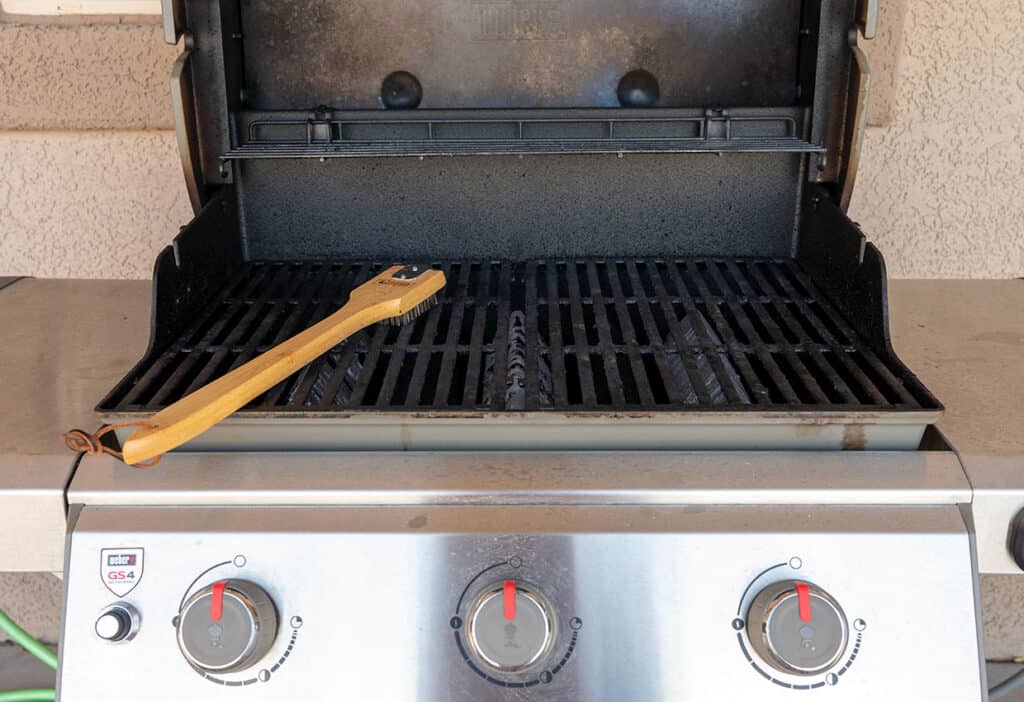Whether you’re taking your grill out of winter hibernation or it’s time to give it the love it deserves, there are a few pitmaster tips for cleaning a grill.

Clean the Grates
No matter if you have a charcoal grill, pellet grill, or gas grill, it’s best to clean the grates after every cook. Once you remove your food from the grill, let the coals burn or heat run for another five minutes or so. Then, use a brush to scrape any food particles from the grate.
If you’re using a wire brush, be sure to check the grates closely to make sure there are no residual bristles.
If you have stubborn, stuck-on food, give the grates a spritz of water from a spray bottle to help loosen it. To reseason the grates, spritz them with a little vegetable oil and let the heat ride for another five minutes before turning the grill off.
For a griddle, it’s also important to clean the surface after every cook. Read tips on how to use and clean a Blackstone Griddle.
Now, your grill is ready for your next batch of hamburgers and steaks.
Clean Inside
If you’re using a charcoal grill, you’ll need to remove the ashes after every cook. Each grill varies. First, wait for the coals to burn out completely. You can speed up this process by closing off the vents to suffocate the oxygen.
For charcoal grills with vents on the bottom, open the vents and push the ash through onto a pan. Other charcoal grills may have ash-collecting pans that can be removed and dumped.
Unfortunately, there are other types of charcoal grills that aren’t as easy and may require you to use a shovel or Shop Vac to remove the coals.
For pellet grills, check your manufacturer’s recommendations, which most likely advise you to remove the pellet ash after every few cooks. Ash removal methods vary between brands.
Some pellet grills have a lever that empties the firepot of ash into a collection tray. Others have vacuum attachments. And others require you to fully remove the grates and deflector plate to get to the ash.
No matter the type of pellet grill you have, it is best to vacuum the inside after several cooks to avoid buildup.
The hardest thing to clean on a pellet grill is the deflector plate. Don’t worry about getting it perfectly clean and shiny. Just do your best to scrape off any burnt-on residue. You can spray it with a hose and use soap and water, if needed.
FDL’S 75 Best Bites

Our cookbook with 75 tasty recipes will be your go-to kitchen companion for easy dinners with ad-free recipes right at your fingertips. Crafted by experienced chefs and recipe developers, this collection offers a treasure trove of tried-and-true dishes that make mealtime a breeze.
Get the Recipe: FDL’S 75 Best Bites
Cleaning the inside of a gas grill is pretty straightforward. Remove the clean grates. Below them, you’ll find either the burners or bars covering the burners.
If the bars have buildup on them, use a scraper to clean them off. Then, remove them until the burners are exposed. Check around the burner vent holes to make sure there’s no residue clogging them.
Then, scrape around the rest of the grill chamber, pushing the residue toward the grease collector on the bottom.
Clean Grease Collectors
Most grills have some sort of pan that collects grease. Be sure to check it after every few cooks. As it starts to fill up, it’s important to empty it to avoid overflow and fire.
With most grills, the pan is removable. Once you pour or scrape out the oil and grease into the trash, wash the pan with soap and water.
For even easier cleanup, line the pan with foil or use a disposable foil pan that fits your grill type.
Reassemble Components
Once your grill components have been cleaned, it’s important to reassemble everything in the proper order.
Start by adding the grease collector back. For charcoal grills, all you have to do is add the grill grates back inside.
For a gas grill, add the bars back over the burners and then the grates.
For a pellet grill, add the deflector plate back inside. To make cleanup even easier next time, line it with heavy-duty foil. This way, after every few cooks, you can just lift off the foil and replace it with a clean sheet. Finally, add the grates back in.
Clean Exterior
The outside of a grill will get dirty, too. If it’s just covered in dust or light debris, wipe it down with a rag with warm soap and water.
If there is grease built up, use a spray-on degreaser with a paper towel or rag.
For those beautiful stainless steel grills, finish the cleaning process with a stainless steel cleaner to make it nice and shiny.
Test Temperatures
Every now and then, it’s a good idea to double-check the accuracy of the grill temperature.
For gas grills and pellet grills, set the temperature on the grill. Then, insert an ambient grill thermometer onto the grill grate. Let it run for a good 15 to 20 minutes and check the readout.
Hopefully, the instant thermometer matches your grill’s thermometer. If not, check with your manual to see if any adjustments should be made, or continue to monitor with a reliable external thermometer with each cook.
Keep It Covered
After all that work, protect your grill by keeping it covered. Most manufacturers make covers to fit their grills exactly.
There are also many after-market products that fit common grills or that are semi-universal.
Covering a grill will protect it from elements like wind, rain, and dust and will help the grill last longer.
Now that your grill is all clean, you can focus on other fun outdoor activities like growing your own vertical garden.